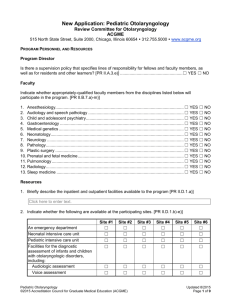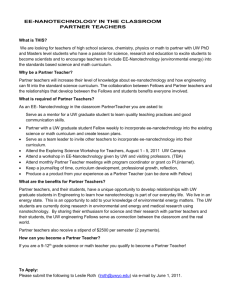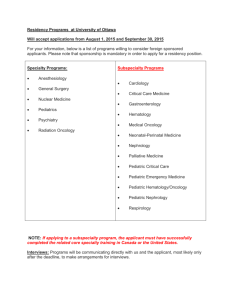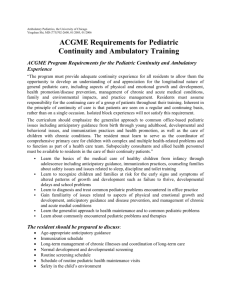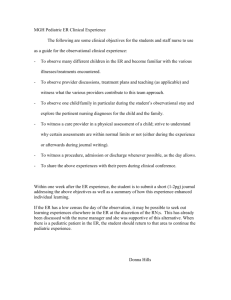Pediatric Anesthesiology
advertisement
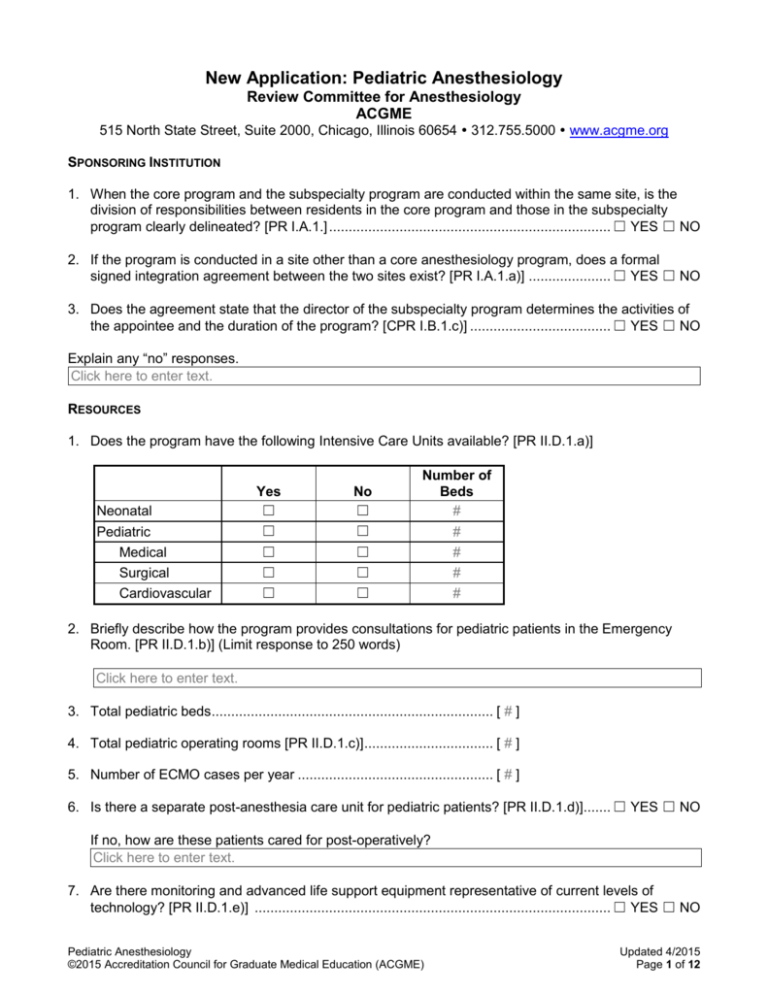
New Application: Pediatric Anesthesiology Review Committee for Anesthesiology ACGME 515 North State Street, Suite 2000, Chicago, Illinois 60654 312.755.5000 www.acgme.org SPONSORING INSTITUTION 1. When the core program and the subspecialty program are conducted within the same site, is the division of responsibilities between residents in the core program and those in the subspecialty program clearly delineated? [PR I.A.1.] ........................................................................ ☐ YES ☐ NO 2. If the program is conducted in a site other than a core anesthesiology program, does a formal signed integration agreement between the two sites exist? [PR I.A.1.a)] ..................... ☐ YES ☐ NO 3. Does the agreement state that the director of the subspecialty program determines the activities of the appointee and the duration of the program? [CPR I.B.1.c)] .................................... ☐ YES ☐ NO Explain any “no” responses. Click here to enter text. RESOURCES 1. Does the program have the following Intensive Care Units available? [PR II.D.1.a)] Neonatal Pediatric Medical Surgical Cardiovascular Yes ☐ ☐ ☐ ☐ ☐ No ☐ ☐ ☐ ☐ ☐ Number of Beds # # # # # 2. Briefly describe how the program provides consultations for pediatric patients in the Emergency Room. [PR II.D.1.b)] (Limit response to 250 words) Click here to enter text. 3. Total pediatric beds ........................................................................ [ # ] 4. Total pediatric operating rooms [PR II.D.1.c)] ................................. [ # ] 5. Number of ECMO cases per year .................................................. [ # ] 6. Is there a separate post-anesthesia care unit for pediatric patients? [PR II.D.1.d)]....... ☐ YES ☐ NO If no, how are these patients cared for post-operatively? Click here to enter text. 7. Are there monitoring and advanced life support equipment representative of current levels of technology? [PR II.D.1.e)] ........................................................................................... ☐ YES ☐ NO Pediatric Anesthesiology ©2015 Accreditation Council for Graduate Medical Education (ACGME) Updated 4/2015 Page 1 of 12 8. Will clinical services that provide prompt laboratory results pertinent to the care of pediatric patients be available, including: [PR II.D.1.f)] a) b) c) d) e) blood chemistries ................................................................................................... ☐ YES ☐ NO blood gases and pH ............................................................................................... ☐ YES ☐ NO oxygen saturation ................................................................................................... ☐ YES ☐ NO hematocrit/hemoglobin ........................................................................................... ☐ YES ☐ NO clotting function ...................................................................................................... ☐ YES ☐ NO 9. Will fellows have prompt access to consultation with personnel from the following disciplines? [PR II.D.1.g)] a) b) c) d) e) f) g) h) Cardiology .............................................................................................................. ☐ YES ☐ NO Critical care ............................................................................................................ ☐ YES ☐ NO Emergency medicine .............................................................................................. ☐ YES ☐ NO Neonatology ........................................................................................................... ☐ YES ☐ NO Neurology............................................................................................................... ☐ YES ☐ NO Pulmonology ......................................................................................................... ☐ YES ☐ NO Radiology ............................................................................................................... ☐ YES ☐ NO Surgical fields ......................................................................................................... ☐ YES ☐ NO 10. Is there a clinical laboratory that provides prompt and readily available diagnostic and laboratory measurements pertinent to the care of obstetric patients? ........................................... ☐ YES ☐ NO 11. Clinical Pediatric Anesthesia Experience Provide the data requested for each participating site listed in ADS. Inclusive Dates: Click here to enter a date. To: Site #1 Site #2 Total Peds Total Peds Number of Anesthetics Administered Annually by: Residents and/or fellows # # # # Attending staff # # # # CRNAs # # # # Total # # # # Anesthetizing Locations # of operating rooms # # # # # used regularly and # # # # simultaneously Click here to enter a date. Site #3 Total Peds Site #4 Total Peds # # # # # # # # # # # # # # # # # # # # # # # # Other Anesthetizing Areas (name and describe function) Click here to enter text. Pediatric Anesthesiology ©2015 Accreditation Council for Graduate Medical Education (ACGME) Updated 4/2015 Page 2 of 12 Total # for Reporting Year by Site Type of Surgery Cardiac - with cardiopulmonary bypass Cardiac - without cardiopulmonary bypass Intra-thoracic - non-cardiac (intracavitary) Intra-cranial - neuro (excluding shunts) Intraabdominal (intracavitary; excluding inguinal hernia) Solid organ transplant Kidney Heart Liver Lung Major orthopaedic surgery (scoliosis, tumors) Craniofacial surgery Cleft lip palate Airway surgery (excluding T&A) Neonatal emergencies (neonates <1 month and prematures <45 weeks PCA) TEF (tracheoesophageal fistula) Gastroschisis and/or Omphalocele Diaphragmatic hernia Necrotizing enterocolitis and bowel obstruction Other Click here to enter text. Other Click here to enter text. Age of Patient Neonates < one month or prematures <45 weeks PCA 1-11 months 1-2 years 3-11 years Site #1 Site #2 Site #3 Site #4 Estimated average # cases per fellow at end of year # # # # # # # # # # # # # # # # # # # # # # # # # # # # # # # # # # # # # # # # # # # # # # # # # # # # # # # # # # # # # # # # # # # # # # # # # # # # # # # # # # # # # # # # # # # # # # # # # # # # # # # # # # # # # # # # # # # # # # # # # # # # # Pediatric Anesthesiology ©2015 Accreditation Council for Graduate Medical Education (ACGME) Updated 4/2015 Page 3 of 12 Total # for Reporting Year by Site Site #1 Site #2 12-17 years # # Greater than 18 years # # Total number of cases # # Techniques for Anesthesia (not pain) General # # Epidural/caudal # # Intrathecal # # Peripheral nerve block # # Procedures Central venous # # cannulation Arterial cannulation # # Flexible fiberoptic # # intubation Pain Management Outside Operating Room Consultations # # PCA # # Peripheral nerve blocks # # Central neuraxis blocks # # Site #3 # # # Site #4 # # # Estimated average # cases per fellow at end of year # # # # # # # # # # # # # # # # # # # # # # # # # # # # # # # # # # # # 12. Clinical Program a) Distribution of pediatric clinical cases for a recent 12-month period. Inclusive Dates: Click here to enter a date. Provide the number for all surgical services General surgery Cardiac surgery Plastic surgery (includes craniofacial) Orthopaedic surgery Ophthalmology Urologic surgery Neurological surgery Otolaryngology Oral and dental surgery (excluding T&A) Transplantation: Kidney Heart Liver To: Click here to enter a date. Site #1 # # # # # # # # Site #2 # # # # # # # # Site #3 # # # # # # # # Site #4 # # # # # # # # # # # # # # # # # # # # # # # # # # # # Pediatric Anesthesiology ©2015 Accreditation Council for Graduate Medical Education (ACGME) Updated 4/2015 Page 4 of 12 Provide the number for all surgical services Lung Non-OR diagnostic and therapeutic procedures (MRI, CT scan, radiation therapy, cardiac catheterization, etc.) Site #1 # Site #2 # Site #3 # Site #4 # # # # # b) What percent of the total of the above cases are performed on an ambulatory basis? ........... # % c) What percent of the total of the above cases are performed on an emergency basis? ........... # % 13. Clinical Curriculum a) Describe the experience, faculty teaching, and supervision which will be provided in preoperative assessment, intra-operative, and post-operative management of children scheduled for surgery. [PR IV.A.4.a)] Click here to enter text. b) Describe rotations outside the integrated sites that will be provided for the purpose of supplemental experience. Click here to enter text. c) Describe the differences in responsibilities for the fellows from those of the core anesthesiology residents. [PR III.B.2.] Click here to enter text. d) Describe the planned degree of interaction between the fellows and the residents in the core anesthesiology program. [PR III.B.2.] Click here to enter text. EDUCATIONAL PROGRAM Patient Care 1. Indicate the settings and activities in which fellows will demonstrate competence in evaluating and treating patients in each of the categories listed below. Also indicate the method(s) that will be used to assess competence. Competency Area Providing clinical consultation for both medical and surgical pediatric patients under the direction of faculty members, including assessment of the appropriateness of a patient’s preparation for surgery [PR IV.A.2.a).(1).(a)] Settings/Activities Click here to enter text. Pediatric Anesthesiology ©2015 Accreditation Council for Graduate Medical Education (ACGME) Assessment Method(s) Click here to enter text. Updated 4/2015 Page 5 of 12 Competency Area Patient management and perioperative care of neonates, infants, children, and adolescents, including: [PR IV.A.2.a).(1).(b)] Pre-operative assessment [PR IV.A.2.a).(1).(b).(i)] Pharmacologic support of the circulation [PR IV.A.2.a).(1).(b).(ii)] Management of both normal peri-operative fluid therapy and massive fluid and/or blood loss [PR IV.A.2.a).(1).(b).(iii)] Interpretation of laboratory results [PR IV.A.2.a).(1).(b).(iv)] Post-anesthetic assessment and management of routine and medically challenging pediatric patients [PR IV.A.2.a).(1).(b).(v)] Recognition, prevention, and treatment of pain in medical and surgical pediatric patients [PR IV.A.2.a).(1).(b).(vi)] Recognition and treatment of peri-operative vital organ dysfunction, including the post-anesthesia care unit [PR IV.A.2.a).(1).(b).(vii)] Diagnosis and perioperative management of congenital and acquired disorders [PR IV.A.2.a).(1).(b).(viii)] Participation in the care of critically-ill pediatric patients in an neonatal and/or pediatric intensive care unit [PR IV.A.2.a).(1).(b).(ix)] Settings/Activities Click here to enter text. Assessment Method(s) Click here to enter text. Click here to enter text. Click here to enter text. Click here to enter text. Click here to enter text. Click here to enter text. Click here to enter text. Click here to enter text. Click here to enter text. Click here to enter text. Click here to enter text. Click here to enter text. Click here to enter text. Click here to enter text. Click here to enter text. Click here to enter text. Click here to enter text. Click here to enter text. Click here to enter text. 2. Indicate the settings and activities in which fellows will develop competence in performing all medical, diagnostic, and surgical procedures considered essential for practice in pediatric anesthesiology. Also indicate the method(s) that will be used to assess competence. Competency Area Managing pediatric patients Settings/Activities Click here to enter text. Pediatric Anesthesiology ©2015 Accreditation Council for Graduate Medical Education (ACGME) Assessment Method(s) Click here to enter text. Updated 4/2015 Page 6 of 12 Competency Area requiring general anesthesia for elective and emergent surgery for a wide variety of surgical conditions, including neonatal surgical emergencies, cardiopulmonary bypass, and congenital disorders, including: [PR IV.A.2.a).(2).(a)] Techniques for administering regional anesthesia for inpatient and ambulatory surgery [PR IV.A.2.a).(2).(a).(i)] Sedation or anesthesia outside the operating rooms, including those for patients undergoing procedures [PR IV.A.2.a).(2).(a).(ii)] Cardiopulmonary resuscitation (CPR) and advanced life support [PR IV.A.2.a).(2).(a).(iii)] Management of normal and abnormal airways [PR IV.A.2.a).(2).(a).(iv)] Mechanical ventilation [PR IV.A.2.a).(2).(a).(v)] Temperature regulation [PR IV.A.2.a).(2).(a).(vi)] Placement of venous and arterial catheters [PR IV.A.2.a).(2).(a).(vii)] Settings/Activities Assessment Method(s) Click here to enter text. Click here to enter text. Click here to enter text. Click here to enter text. Click here to enter text. Click here to enter text. Click here to enter text. Click here to enter text. Click here to enter text. Click here to enter text. Click here to enter text. Click here to enter text. Click here to enter text. Click here to enter text. 3. Pediatric advanced life support: Are all fellows certified as providers of pediatric advanced life support? [PR IV.A.2.a).(2).(b)] ...................................................................................... ☐ YES ☐ NO Medical Knowledge Indicate the activity(ies) (lectures, conferences, journal clubs, clinical teaching rounds, etc.) in which residents will demonstrate knowledge in each of the following areas. Also indicate the method(s) that will be used to assess competence. Area of Knowledge Neonatal physiology and pharmacology [PR IV.A.2.b).(1)] Effects of anesthetics on the developing brain [PR IV.A.2.b).(2)] Settings/Activities Click here to enter text. Assessment Method(s) Click here to enter text. Click here to enter text. Click here to enter text. Pediatric Anesthesiology ©2015 Accreditation Council for Graduate Medical Education (ACGME) Updated 4/2015 Page 7 of 12 Area of Knowledge CPR [PR IV.A.2.b).(3)] Pharmacokinetics and pharmacodynamics, and mechanisms of drug delivery [PR IV.A.2.b).(4)] Cardiovascular, respiratory, renal, hepatic, and central nervous system physiology, pathophysiology, and therapy [PR IV.A.2.b).(5)] Metabolic and endocrine effects of surgery and critical illness [PR IV.A.2.b).(6)] Infectious disease pathophysiology and therapy [PR IV.A.2.b).(7)] Coagulation abnormalities and therapy [PR IV.A.2.b).(8)] Normal and abnormal physical and psychological development [PR IV.A.2.b).(9)] Trauma, including burn management [PR IV.A.2.b).(10)] Congenital anomalies and developmental delay [PR IV.A.2.b).(11)] Medical and surgical problems common in children [PR IV.A.2.b).(12)] Use and toxicity of local and general anesthetic agents [PR IV.A.2.b).(13)] Airway problems common in children [PR IV.A.2.b).(14)] Pain management in pediatric patients of all ages [PR IV.A.2.b).(15)] Ethical and legal aspects of care [PR IV.A.2.b).(16)] Transport of critically-ill patients [PR IV.A.2.b).(17)] Organ transplantation in children [PR IV.A.2.b).(18)] Post-anesthetic care and critical care management Settings/Activities Click here to enter text. Assessment Method(s) Click here to enter text. Click here to enter text. Click here to enter text. Click here to enter text. Click here to enter text. Click here to enter text. Click here to enter text. Click here to enter text. Click here to enter text. Click here to enter text. Click here to enter text. Click here to enter text. Click here to enter text. Click here to enter text. Click here to enter text. Click here to enter text. Click here to enter text. Click here to enter text. Click here to enter text. Click here to enter text. Click here to enter text. Click here to enter text. Click here to enter text. Click here to enter text. Click here to enter text. Click here to enter text. Click here to enter text. Click here to enter text. Click here to enter text. Click here to enter text. Click here to enter text. Click here to enter text. Click here to enter text. Pediatric Anesthesiology ©2015 Accreditation Council for Graduate Medical Education (ACGME) Updated 4/2015 Page 8 of 12 Area of Knowledge [PR IV.A.2.b).(19)] Settings/Activities Assessment Method(s) Practice-based Learning and Improvement 1. Briefly describe one planned quality improvement activity or project that will allow fellows to demonstrate an ability to analyze, improve, and change practice or patient care. Describe planning, implementation, evaluation, and provisions of faculty member support and supervision that will guide this process. [PR IV.A.2.c).(1)] (Limit response to 400 words) Click here to enter text. 2. Briefly describe one example of a learning activity in which fellows engage to develop the skills needed to locate, appraise, and assimilate evidence from scientific studies and apply it to their patients' health problems. [PR IV.A.2.c).(2)] (Limit response to 400 words) The description should include: Locating information Appraising information Assimilating evidence information (from scientific studies) Applying information to patient care Click here to enter text. 3. Briefly describe one example of a learning activity in which fellows will demonstrate development of self-assessment and reflection skills and habits. [PR IV.A.2.c).(3)] (Limit response to 400 words) Click here to enter text. Interpersonal and Communication Skills 1. Briefly describe one learning activity in which fellows develop interpersonal and communication skills that result in the effective exchange of information and collaboration with patients, their families, and health professionals. [PR IV.A.2.d)] (Limit response to 400 words) Click here to enter text. 2. Briefly describe one learning activity in which fellows will demonstrate effective communication skills in acquisition of informed consent; description, and management of the patient care plan; and disclosure and management of complications/errors. [PR IV.A.2.d).(1)] (Limit response to 400 words) Click here to enter text. 3. Briefly describe one learning activity in which fellows will demonstrate the ability to effectively teach other resident physicians, medical students, and other health care professionals the principles of pediatric anesthesiology, including management of patients requiring sedation outside the operating rooms, pain management, and life support. [PR IV.A.2.d).(2)] (Limit response to 400 words) Click here to enter text. 4. Briefly describe one learning activity in which fellows will demonstrate competence in providing Pediatric Anesthesiology ©2015 Accreditation Council for Graduate Medical Education (ACGME) Updated 4/2015 Page 9 of 12 psychological support to patients and their families. [PR IV.A.2.d).(3)] (Limit response to 400 words) Click here to enter text. Professionalism 1. Briefly describe the learning activity(ies), other than lecture, by which fellows demonstrate a commitment to carrying out professional responsibilities and an adherence to ethical principles, including: compassion, integrity, and respect for others; responsiveness to patient needs that supersedes self-interest; respect for patient privacy and autonomy; accountability to patients, society, and the profession; and sensitivity and responsiveness to a diverse patient population, including to diversity in gender, age, culture, race, religion, disabilities, and sexual orientation. [PR IV.A.2.e).(1)-(5)] (Limit response to 400 words) Click here to enter text. 2. Briefly describe one learning activity by which fellows will demonstrate compliance with institutional, departmental, and program policies. [PR IV.A.2.e).(6)] (Limit response to 400 words) Click here to enter text. Systems-based Practice 1. Describe the learning activity(ies) through which fellows demonstrate an awareness of and responsiveness to the larger context and system of health care, as well as the ability to call effectively on other resources in the system to provide optimal health care. [PR IV.A.2.f)] (Limit response to 400 words) Click here to enter text. 2. Briefly describe one learning activity in which fellows will work in interprofessional teams to enhance patient safety and improve patient care quality. [PR IV.A.2.f).(1)] (Limit response to 400 words) Click here to enter text. 3. Briefly describe one learning activity in which fellows will identify system errors and assist in the implementation of potential system solutions. [PR IV.A.2.f).(2)] (Limit response to 400 words) Click here to enter text. 4. Briefly describe one learning activity in which fellows will be involved in continuous quality improvement, utilization review, and risk management. [PR IV.A.2.f).(3)] (Limit response to 400 words) Click here to enter text. Curriculum Organization and Fellow Experiences 1. Intra-departmental activities [PR IV.A.3.b).(1)] Pediatric Anesthesiology ©2015 Accreditation Council for Graduate Medical Education (ACGME) Updated 4/2015 Page 10 of 12 Activity Lectures Conferences or Seminars Morbidity and Mortality Conferences Journal Club # Per Year # Attendance Attendance Obligatory for Faculty Obligatory for Fellows ☐ YES ☐ NO ☐ YES ☐ NO # ☐ YES ☐ NO ☐ YES ☐ NO # ☐ YES ☐ NO ☐ YES ☐ NO # ☐ YES ☐ NO ☐ YES ☐ NO 2. Provide a list of the lectures, seminars, conferences, and other didactic exercises planned. Include all presentations represented in the curriculum, designating those specific to the fellowship with an asterisk. Include the date, title, and instructor and whether the presenter was a faculty member, fellow, or guest. Add rows as necessary. [PR IV.A.3.b).(1)] Date Title Instructor Check as appropriate Faculty Fellow Guest 3. Estimate the proportion (%) of the didactic program provided by each of the following: [PR IV.A.3.b).(3)] Anesthesia faculty/staff members of this hospital Non-anesthesiologist physicians from this hospital Anesthesia faculty/staff members from affiliated or integrated hospitals Outside speakers Fellow assignments or contributions #% #% #% #% #% 4. Will fellows be regularly relieved from operating room assignments to attend conferences during elective operating schedule time? [PR IV.A.3.b).(3)] ................................................... ☐ YES ☐ NO By whom? Click here to enter text. Fellows’ Scholarly Activities 1. Describe and list fellows’ research opportunities and ongoing projects. [PR IV.B.1.] Click here to enter text. 2. Describe fellows' participation in planning and conducting conferences and other teaching activities. [PR IV.B.1.] Click here to enter text. Pediatric Anesthesiology ©2015 Accreditation Council for Graduate Medical Education (ACGME) Updated 4/2015 Page 11 of 12 3. What provisions will be made for fellows to attend local, regional, and national meetings? [PR IV.B.2.] Click here to enter text. Pediatric Anesthesiology ©2015 Accreditation Council for Graduate Medical Education (ACGME) Updated 4/2015 Page 12 of 12




